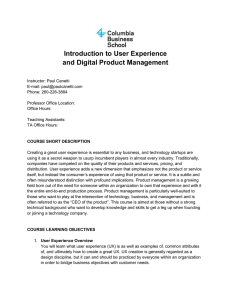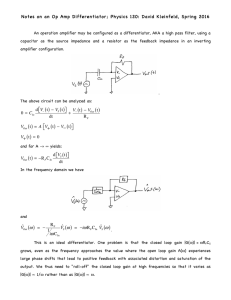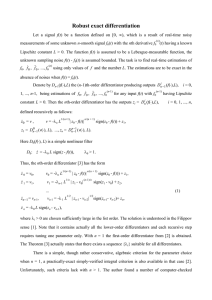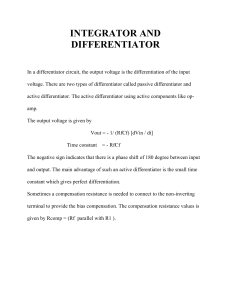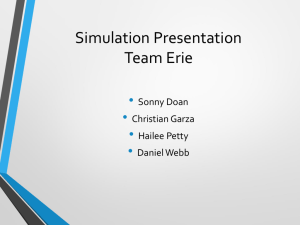Implementation of First-Order and Second
advertisement
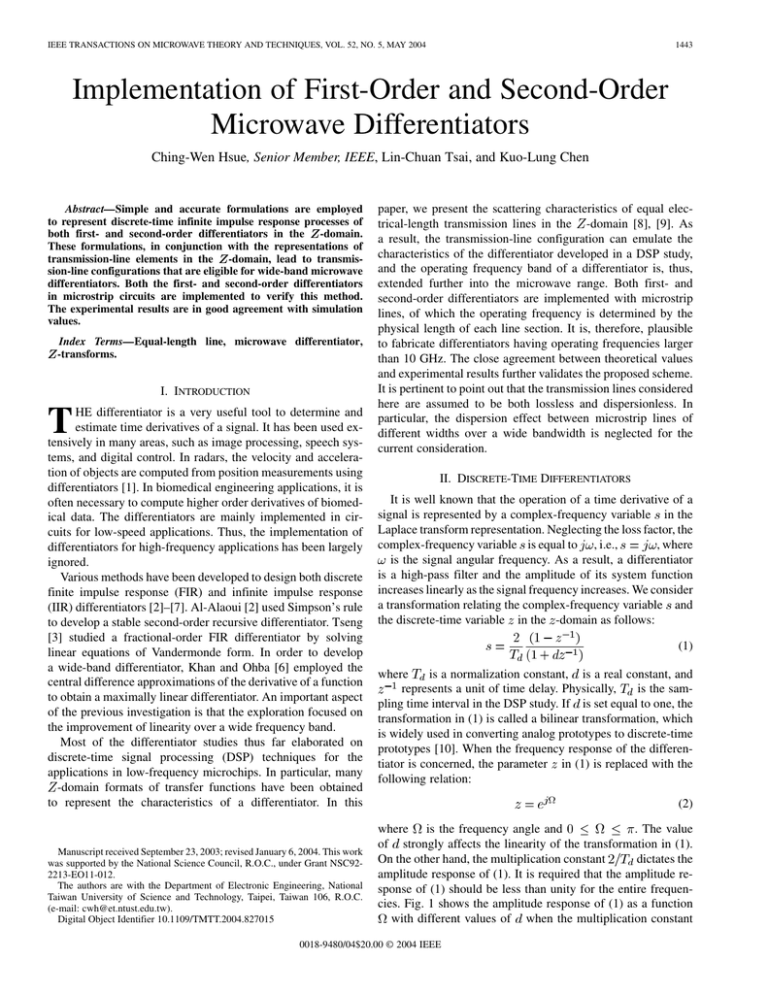
IEEE TRANSACTIONS ON MICROWAVE THEORY AND TECHNIQUES, VOL. 52, NO. 5, MAY 2004 1443 Implementation of First-Order and Second-Order Microwave Differentiators Ching-Wen Hsue, Senior Member, IEEE, Lin-Chuan Tsai, and Kuo-Lung Chen Abstract—Simple and accurate formulations are employed to represent discrete-time infinite impulse response processes of both first- and second-order differentiators in the -domain. These formulations, in conjunction with the representations of transmission-line elements in the -domain, lead to transmission-line configurations that are eligible for wide-band microwave differentiators. Both the first- and second-order differentiators in microstrip circuits are implemented to verify this method. The experimental results are in good agreement with simulation values. Index Terms—Equal-length line, microwave differentiator, -transforms. I. INTRODUCTION T HE differentiator is a very useful tool to determine and estimate time derivatives of a signal. It has been used extensively in many areas, such as image processing, speech systems, and digital control. In radars, the velocity and acceleration of objects are computed from position measurements using differentiators [1]. In biomedical engineering applications, it is often necessary to compute higher order derivatives of biomedical data. The differentiators are mainly implemented in circuits for low-speed applications. Thus, the implementation of differentiators for high-frequency applications has been largely ignored. Various methods have been developed to design both discrete finite impulse response (FIR) and infinite impulse response (IIR) differentiators [2]–[7]. Al-Alaoui [2] used Simpson’s rule to develop a stable second-order recursive differentiator. Tseng [3] studied a fractional-order FIR differentiator by solving linear equations of Vandermonde form. In order to develop a wide-band differentiator, Khan and Ohba [6] employed the central difference approximations of the derivative of a function to obtain a maximally linear differentiator. An important aspect of the previous investigation is that the exploration focused on the improvement of linearity over a wide frequency band. Most of the differentiator studies thus far elaborated on discrete-time signal processing (DSP) techniques for the applications in low-frequency microchips. In particular, many -domain formats of transfer functions have been obtained to represent the characteristics of a differentiator. In this Manuscript received September 23, 2003; revised January 6, 2004. This work was supported by the National Science Council, R.O.C., under Grant NSC922213-EO11-012. The authors are with the Department of Electronic Engineering, National Taiwan University of Science and Technology, Taipei, Taiwan 106, R.O.C. (e-mail: cwh@et.ntust.edu.tw). Digital Object Identifier 10.1109/TMTT.2004.827015 paper, we present the scattering characteristics of equal electrical-length transmission lines in the -domain [8], [9]. As a result, the transmission-line configuration can emulate the characteristics of the differentiator developed in a DSP study, and the operating frequency band of a differentiator is, thus, extended further into the microwave range. Both first- and second-order differentiators are implemented with microstrip lines, of which the operating frequency is determined by the physical length of each line section. It is, therefore, plausible to fabricate differentiators having operating frequencies larger than 10 GHz. The close agreement between theoretical values and experimental results further validates the proposed scheme. It is pertinent to point out that the transmission lines considered here are assumed to be both lossless and dispersionless. In particular, the dispersion effect between microstrip lines of different widths over a wide bandwidth is neglected for the current consideration. II. DISCRETE-TIME DIFFERENTIATORS It is well known that the operation of a time derivative of a signal is represented by a complex-frequency variable in the Laplace transform representation. Neglecting the loss factor, the , where complex-frequency variable is equal to , i.e., is the signal angular frequency. As a result, a differentiator is a high-pass filter and the amplitude of its system function increases linearly as the signal frequency increases. We consider a transformation relating the complex-frequency variable and the discrete-time variable in the -domain as follows: (1) is a normalization constant, is a real constant, and where represents a unit of time delay. Physically, is the sampling time interval in the DSP study. If is set equal to one, the transformation in (1) is called a bilinear transformation, which is widely used in converting analog prototypes to discrete-time prototypes [10]. When the frequency response of the differentiator is concerned, the parameter in (1) is replaced with the following relation: (2) . The value where is the frequency angle and of strongly affects the linearity of the transformation in (1). dictates the On the other hand, the multiplication constant amplitude response of (1). It is required that the amplitude response of (1) should be less than unity for the entire frequencies. Fig. 1 shows the amplitude response of (1) as a function with different values of when the multiplication constant 0018-9480/04$20.00 © 2004 IEEE 1444 Fig. 1. IEEE TRANSACTIONS ON MICROWAVE THEORY AND TECHNIQUES, VOL. 52, NO. 5, MAY 2004 Amplitude responses with different values of d. Fig. 2. is set equal to 0.417. Apparently, the transformation in (1) has a good linearity in amplitude response when is set equal to 0.1658. The value of 0.417 is selected to assume that the maximum value of in (1) is unity for the entire frequencies when . When is equal to one, the amplitude response of . The bithe system function in (1) becomes infinite at linear transformation, when is one, has a good linearity when . Therefore, the bithe normalized frequency is less than linear transformation is improper to be adopted as the system function of a wide-band differentiator. Fig. 2. shows the relative error of the amplitude response of (1) for different values of when they are compared to an ideal differentiator. The ideal differentiator is assumed to have precisely linear amplitude re, the sponse for all frequencies, as shown in Fig. 1. If . relative error is less than 1% (or 40 dB) when For , we, therefore, adopt (1) as the system function of the differentiator in a discrete-time IIR format and the selected system function of the first-order differentiator is Relative error of amplitude response for different values of d. Fig. 3. Two-port device. that their transfer functions are similar to the system functions of differentiators. III. IMPLEMENTATION OF DIFFERENTIATORS A. First-Order Differentiator For a two-port network shown in Fig. 3, the chain-scattering ( ) of a two-port parameters ( or -parameters) network are defined as follows: (3) (5) If we implement a circuit with the system function shown in (3), the differentiator is accurate for the operating frequency up to 0.8 of the normalizing frequency. With a finite error tolerance, such a differentiator has a wider operating frequency bandwidth than those previously reported [7]. In particular, the concise mathematical expression will lead to a simple circuit configuration of the differentiator. For a second-order differentiator, the system function is obtained by squaring (3), i.e., where and are, respectively, the incident and reflected and are, respectively, the incident waves at port 1, and wave and the reflected wave at port 2. In Fig. 3, and are and are independent varidependent variables, while ables. Table I shows the matrices for two transmission-line configurations [8], [9], namely, the serial transmission line and , , and shunt-short stub in the -domain, where are the propagation constant, physical length, and characteristic is the reference characterimpedance, respectively. Note that istic impedance, which is assumed to be 50 , unless otherwise mentioned. It is assumed that all finite lines have the same electrical , where is the propagation delay length, i.e., time of finite lines. To obtain the matrices in the -domain, . we set From (5), if the output port of a shunt-short stub is loaded with ), the transfer function of a matched termination (i.e., (4) After defining the discrete-time system functions, the remaining task is to implement both first- and second-order differentiators with equal electric-length transmission lines. In other words, we synthesize the transmission-line circuits so HSUE et al.: IMPLEMENTATION OF FIRST- AND SECOND-ORDER MICROWAVE DIFFERENTIATORS 1445 TABLE I BASIC TRANSMISSION-LINE ELEMENT’S CHAIN SCATTERING-PARAMETER MATRICES Fig. 4. Physical layout of microstrips for a first-order differentiator. shunt-short stubs, and the term represents the delay serial transmission-line sections. factor of to approximate the system function in If we set (4) and neglect the propagation delay factor, we obtain the shunt-short stub we obtain is given by . From Table I, (6) where and is the characteristic impedance equal to in (3), we get of the shunt stub. If we set and . Notice that is 17.86 if is 50 . This reveals that a transmission line shunted with a short-circuited stub can be employed to implement a first-order microwave differentiator dictated by (3). B. Second-Order Differentiator serial secIf a transmission-line configuration consists of tions and shunt-short stubs ( and are positive integers), of such a the overall chain-scattering parameter circuit is obtained by the sequential multiplication of chain-scattering parameter matrices of all transmission-line elements [9]. The chain-scattering parameter matrix element is given as (7) where all are real and are determined by the characteristic is the reflecimpedances of all transmission-line elements. tion coefficient defined in Table I. If the output of the transmission-line circuit is loaded with a matched termination, the , is as transfer function of the overall circuit, denoted as follows: (8) where is a function of the characteristic impedances of all shunted and serial transmission-line in the numerator of (8) is due to elements. The term (9) If we divide (9) with , we get (10) The next step is to compare the coefficients of denominators is as close to as poson both sides of (10) so that in (10) is determined by the characteristic sible. Notice that impedances of all transmission lines. Upon using the optimization method [9] in the sense of minimum square error for the coefficients of the denominators in (10), we obtain the characteristic impedances of transmission lines. To implement a differentiator with transmission lines, the electrical length of each transmission-line section is set equal , where to 90 at the normalizing frequency. We have represents the physical length of each transmission-line section and is the wavelength at the normalizing frequency. IV. EXPERIMENTAL RESULTS To construct a first-order microwave differentiator, we employ microstrips to emulate transmission lines. The microstrips are assumed to be both lossless and dispersionless for the current consideration. Fig. 4 shows the physical layout of the microstrips, which is built on a Duroid substrate with a thickness . of 30 mil (0.762 mm) and relative dielectric constant To implement the shunted transmission-line stub having a characteristic impedance of 17.86 , we use a parallel configuration, i.e., the equivalent microstrips are placed symmetrically on both sides of the 50- line. The propagation delay time of each shunted finite line is 20 ps, which corresponds to the normalizing (or maximum operating) frequency of 12.5 GHz. The ground termination of shunted finite lines is implemented by using multiple via-holes along the edges. Fig. 5 shows the magnitude responses of both simulated values and experimental reand reflection cosults of the transmission coefficient 1446 IEEE TRANSACTIONS ON MICROWAVE THEORY AND TECHNIQUES, VOL. 52, NO. 5, MAY 2004 Fig. 5. Magnitude responses of both experimental results and theoretical values of S (f ) and S (f ) of the first-order differentiator. Fig. 7. Magnitude responses of both experimental results and theoretical values of S (f ) and S (f ) of the second-order differentiator. Fig. 6. Physical layout of microstrips for a second-order differentiator. efficient of the first-order differentiator for frequencies extending from dc to 10 GHz. Notice that 10 GHz represents 0.8 of the full-band normalizing frequency. Measured and are in good agreement with the respective theoretincreases linearly as the frequency ical values. Measured increases. We also use microstrips to construct a second-order microwave differentiator. Fig. 6 shows the physical layout of the microstrip circuit, which is built on the same substrate as that used for the first-order differentiator. The circuit consists of ) and three shunted stubs seven-section serial lines ( ). Of course, other configurations can be selected to ( implement the differentiator provided that the condition is met. The characteristic impedances of transmission lines are obtained by using the optimization process [9] that involves the comparison between the coefficients of the denominators on both sides of (10). To assure the feasibility of microstrips, the lower and upper bounds of the characteristic impedances . for the optimization process are set as The characteristic impedances of serial lines from the leftto right-hand side are 54.19, 92.0, 75.54, 40, 40, 54.82, and 61.34 . We also use a parallel configuration to implement the shunted stubs. The characteristic impedances of equivalent shunted stubs from the left- to right-hand side are 49.91, 50.0, and 40.0 . Fig. 8. Response of the first-order differentiator for ramp signal input. Of course, the characteristic impedances of shunt stubs on one side of the serial line in Fig. 6 are twice these values. The propagation delay time of each finite line is 20 ps, which produces the normalizing frequency of 12.5 GHz. Once again, the ground termination of shunted finite lines is implemented by using multiple via-holes along the edges. The total length of the differentiator excluding the reference 50- lines on both sides is 29.43 mm. Fig. 7 shows the experimental results, as well as the and resimulated values of the transmission coefficient flection coefficient of the second-order differentiator for frequencies ranging from dc to 10 GHz. As shown in this figure, the measured frequency-domain results agree very well with the theoretical values for frequencies up to 0.8 of the full-band normalizing frequency. To examine the characteristics of the differentiators in the time domain, we employ ramp signals as input signals to the devices. Fig. 8 shows the experimental results of the first-order differentiator when ramp signals with rise times of 100 and 150 ps HSUE et al.: IMPLEMENTATION OF FIRST- AND SECOND-ORDER MICROWAVE DIFFERENTIATORS 1447 REFERENCES Fig. 9. Response of the second-order differentiator for ramp signal input. are incident upon the device shown in Fig. 4. The 150-ps ramp signal is turned into a square wave, while the 100-ps ramp signal is transformed into a distorted pulse signal. The amplitudes of output signals decrease in both cases. Little ripples appear on both the rising and falling edges of output signals. Notice that the rise time of output signals becomes 50 ps for two different input signals. On the other hand, the output signals have a different fall time. The output signal associated with the 100-ps rise-time input signal has a larger fall time. In Fig. 8, the theoretical results of output signals are shown to compare with the measured results, wherein the propagation delay time of transmission lines is taken into account. Fig. 9 shows the output signals of the second-order differentiator when the same ramp signals are incident upon the device shown in Fig. 6. Both output signals appear as distorted triangular waveforms. The output signal associated with the input signal of 100-ps rise time has a larger peak-to-peak value. In particular, two outputs decrease significantly, and the time duration of two outputs lasts longer than that of output signals in the first-order differentiator. For convenience, the theoretical results of output signals are also shown for comparison with the measured results. [1] M. I. Skolink, Introduction to Radar Systems. New York: McGrawHill, 1980, pp. 399–408. [2] M. A. Al-Alaoui, “Novel IIR differentiator from the Simpson rule,” IEEE Trans. Circuits Syst. I, vol. 41, pp. 186–187, Feb. 1994. [3] C.-C. Tseng, “Design of fractional order digital FIR differentiators,” IEEE Signal Processing Lett., vol. 8, pp. 77–79, Mar. 2001. [4] B. Kumar and S. C. Dutta-Roy, “Design of digital differentiators for low-frequencies,” Proc. IEEE, vol. 76, pp. 287–289, Mar. 1988. [5] S. C. Pei and J. J. Shyu, “Analytic closed-form matrix for designing higher order digital differentiators using eigen-approach,” IEEE Trans. Signal Processing, vol. 44, pp. 698–701, Mar. 1996. [6] I. R. Khan and R. Ohba, “New design of full-band differentiators based on Taylor series,” Proc. Inst. Elect. Eng.–Vis. Image Signal Processing, vol. 146, no. 4, pp. 185–189, Aug. 1999. [7] C.-W. Hsue, T.-R. Cheng, H.-M. Cheng, and H.-M. Chen, “A secondorder microwave differentiator,” IEEE Microwave Wireless Comp. Lett., vol. 13, pp. 137–139, Mar. 2003. [8] T.-R. Cheng and C.-W. Hsue, “High-speed waveshaping using nonuniform lines and Z transform technique,” Proc. Inst. Elect. Eng., vol. 150, pp. 77–83, Apr. 2003. [9] D.-C. Chang and C.-W. Hsue, “Design and implementation of filters using transfer functions in the Z domain,” IEEE Trans. Microwave Theory Tech., vol. 49, pp. 979–985, May 2001. [10] A. V. Oppenheim and R. W. Shafer, Discrete-Time Signal Processing. Englewood Cliffs, NJ: Prentice-Hall, 1989. [11] T. Edward, Foundations for Microstrip Circuit Design. New York: Wiley, 1991. Ching-Wen Hsue (S’85–M’85–SM’91) was born in Tainan, Taiwan, R.O.C. He received the B.S. and M.S. degrees in electrophysics and electronics from the National Chiao-Tung University, Hsin-Chu, Taiwan, R.O.C., in 1973 and 1975, respectively, and the Ph.D. degree from the Polytechnic University (formerly the Polytechnic Institute of Brooklyn), Brooklyn, NY, in 1985. From 1975 to 1980, he was a Research Engineer with the Telecommunication Laboratories, Ministry of Communication, Taiwan, R.O.C. From 1985 to 1993, he was with Bell Laboratories, Princeton, NJ, as a Member of Technical Staff. In 1993, he joined the Department of Electronic Engineering, National Taiwan University of Science and Technology, Taipei, Taiwan, R.O.C., as a Professor, and from August 1997 to July 1999, he was the Department Chairman. His current interests are in pulse-signal propagation in lossless and lossy transmission media, wave interactions between nonlinear elements and transmission lines, photonics, high-power amplifiers, and electromagnetic inverse scattering. V. CONCLUSION Simple and accurate formulations have been employed to represent both first- and second-order differentiators in the -domain. In particular, the -domain representations of scattering characteristics of equal-length nonuniform transmission lines facilitate the implementation of discrete-domain differentiators in the microwave frequency range. These differentiators have been implemented by using microstrip transmission lines. The experimental results agreed very well with the simulated values. It is possible that many other circuits developed in DSP studies can also be implemented by using transmission lines for microwave applications. Lin-Chuan Tsai was born in Taipei, Taiwan, R.O.C., in 1968. He received the M.S. degree in electronic engineering from the National Taiwan University of Science and Technology, Taipei, Taiwan, R.O.C., in 1998, and is currently working toward the Ph.D. degree in electronic engineering at the National Taiwan University of Science and Technology. He is currently a Project Engineer with the Mobile Business Group, Chunghwa Telecom, Taipei, Taiwan, R.O.C., where he is involved with the wide-band code division multiple access (WCDMA) network planning. His current interests are discrete time signal processing, wireless communications, and microwave planar filter design and passive circuit design. 1448 IEEE TRANSACTIONS ON MICROWAVE THEORY AND TECHNIQUES, VOL. 52, NO. 5, MAY 2004 Kuo-Lung Chen was born in Keelung, Taiwan R.O.C., in 1954. He received the B.S. degree in textile engineering from the National Taiwan University of Science and Technology, Taipei, Taiwan, R.O.C., in 1980, the M.S. degree in computer science and information engineering from the National Chiao-Tung University, Hsin-Chu, Taiwan, R.O.C., in 1995, and is currently working toward the Ph.D. degree in electronic engineering at the National Taiwan University of Science and Technology. From 1981 to 1996, he was an Engineer with the Data Communications Institute, Ministry of Transportation and Communications (MOTC), Taiwan, R.O.C. From July 1996 to 1998, he was a Section Chief with the Public Telecommunications Department, Directorate General of Telecommunications (DGT). From October 1998 to July 2003, he was a Station Director of the Northern Taiwan Regulatory Station, DGT, MOTC. He is currently a Deputy Director of Public Telecommunications Department, Directorate General of Telecommunications. His current interests are discrete-time signal processing, wireless asynchronous transfer mode (ATM), microwave planar filter design, and passive circuit design.
